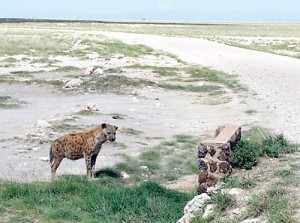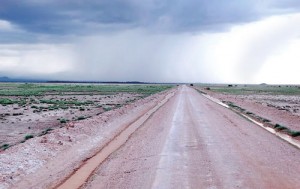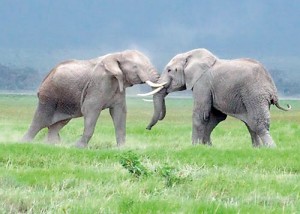Humbling experience in an African landscape
“Once in the south of Kenya, I knew a tame elephant. It used to come to a hotel restaurant at lunchtime. Eat a few fruits, drink a beer and go back. Then one day, at lunchtime it forgot that it was tame and smashed up everything, the cutlery, the plates and a few humans too,” says Daniel, our guide. “ African elephants cannot be tamed. They forget.”

Close encounter with a Hyena
We are in the Amboseli National Park in Kenya, best known as a place to see free-ranging African elephants, finally managing to convince the Kikuyu guide that Sri Lankan elephants are superior to their African counterparts. Despite this boost to our collective ego, we are surrounded by a humbling landscape. The dusty plain with its patches of sparse vegetation and the endless sky together with the lack of any activity or landmark on the horizon impresses on us, our total insignificance in this out of the way setting. Amboseli is a place where the rain can transform the topsoil into impassable mud which the sun can later dry up only to be caught into enormous dust swirls by the wind.
A herd of elephants emerges in the distance with several babies in their midst. The she elephants do not seem aggressive and Daniel drives up to them without any hesitation. As we look on, only a trunk’s distance from them, one by one the elephants, 18 in all, form a line with an ancient tusker at the front. The giants lumber along at a gentle pace so that the babies, on their small feet, can keep up.Their path, probably leading to a waterhole, is well worn. Amboseli is home to nearly 1200 elephants and soon we spot a pair of elephants locking their tusks in a show of aggression. The larger tusker has the upper hand and soon his rival decides the risk is not worth it and retreats.
With salty soil and minimal rainfall, Amboseli is notorious for its fragile vegetation and safari vehicles are not allowed to drive off the roads

On the road to dusty, salty Amboseli. Pix by Kaveesha Liyanage
unlike in some other Kenyan National Parks. In an attempt to bring back the vegetation some areas of the park have been reforested. To prevent elephants from grazing on these trees they are enclosed by electric fences with narrow entrances hung with wires. This area of the park is somewhat wooded and Yellow Baboons sit in the shade popping everything from grasses to grasshoppers into their mouths.
In contrast to the chilly morning, the midday sun reaches a scorching ferocity and we are thankful for the roof over our heads. The landscapes keep changing along the network of roads and in an area with no sign of shelter we see a full grown hyena peering into a culvert. Rather than drive over the culvert Daniel drives alongside it. Another hyena is stretched out in the shade of the concrete tube, clearly unwilling to share the shelter with another of its kind.
Sparing a thought for the unlucky hyena we drive on towards the ‘Noomotio Observation

Elephants locking tusks in a show of aggression
Hill’, a hillock formed in the Pleistocene Era following Mount Kilimanjaro’s eruption. The short climb up the hill is no feat for Daniel but we can almost feel our skin sizzling.Our vantage point offers a sweeping panorama of the park including its swamps where black and white feathered Ibises, considered sacred in the African Continent, forage in the water along the papyrus and reed edged banks.
Since the drive out from the park too is a considerable distance on the bumpy roads we resume our journey. In an area where the grass grows taller Daniel stops the safari van and peers out through his binoculars. “Those with good eyes will see them,” he winks and points out a lion and lioness, far away, placidly walking together towards the shade of an Acacia. We can only wonder at his expertise in spotting them, camouflaged as they are among the honey coloured grass. With that lovely image we leave the park from the ‘Kimana Gate’ hoping to return the next day.


